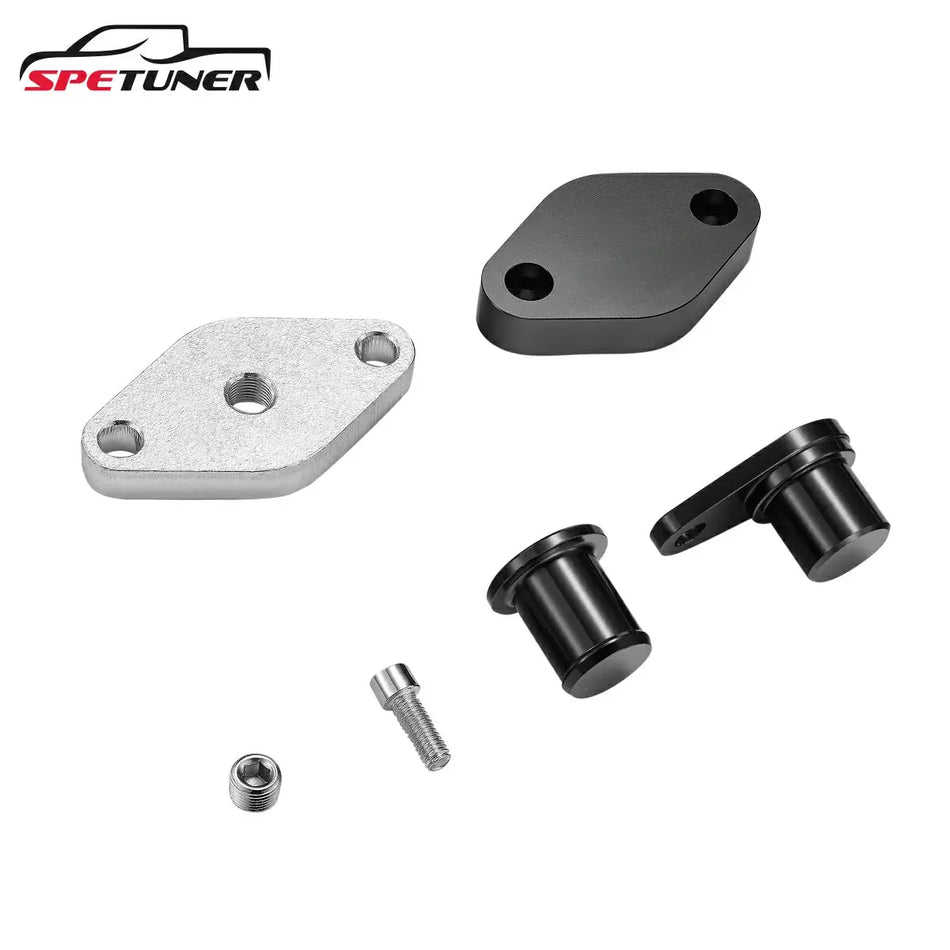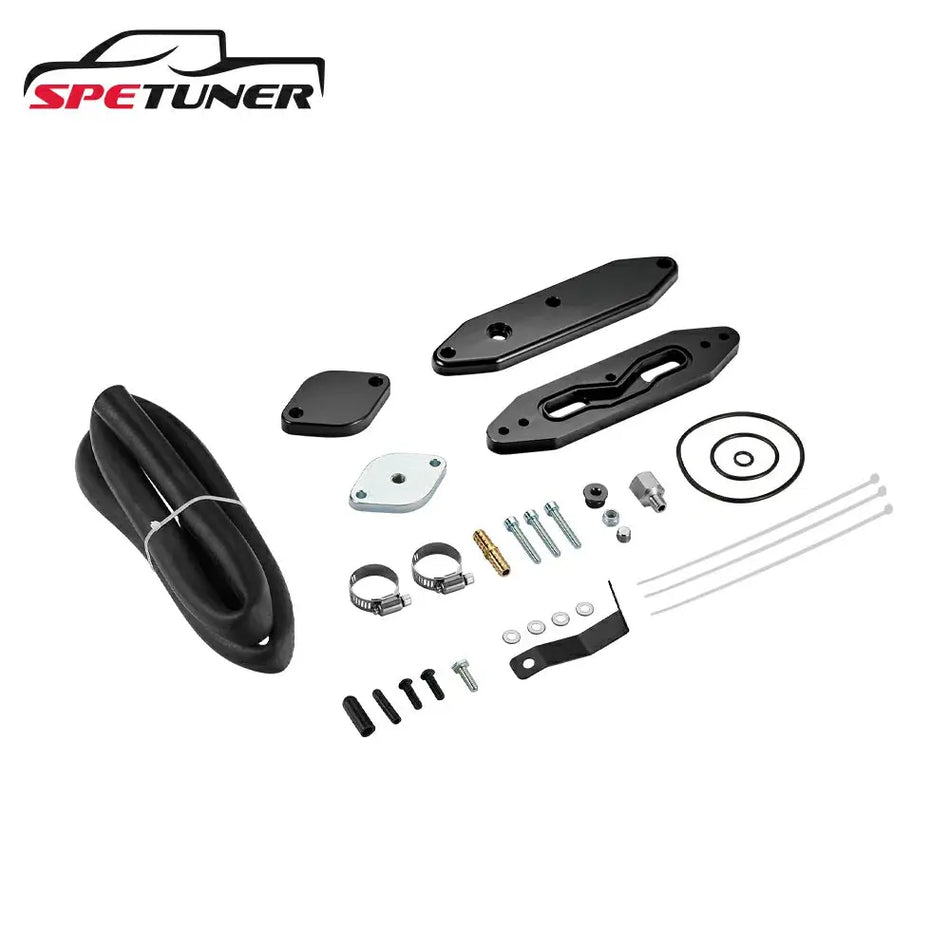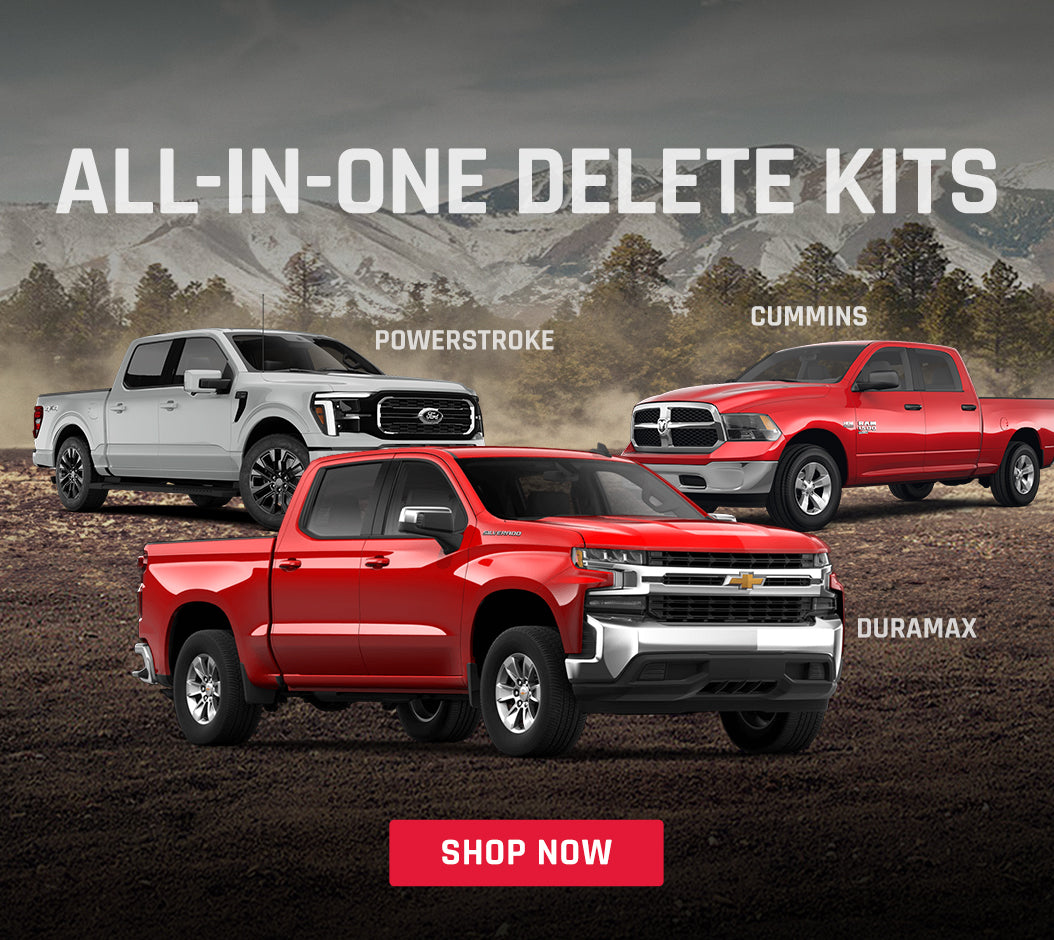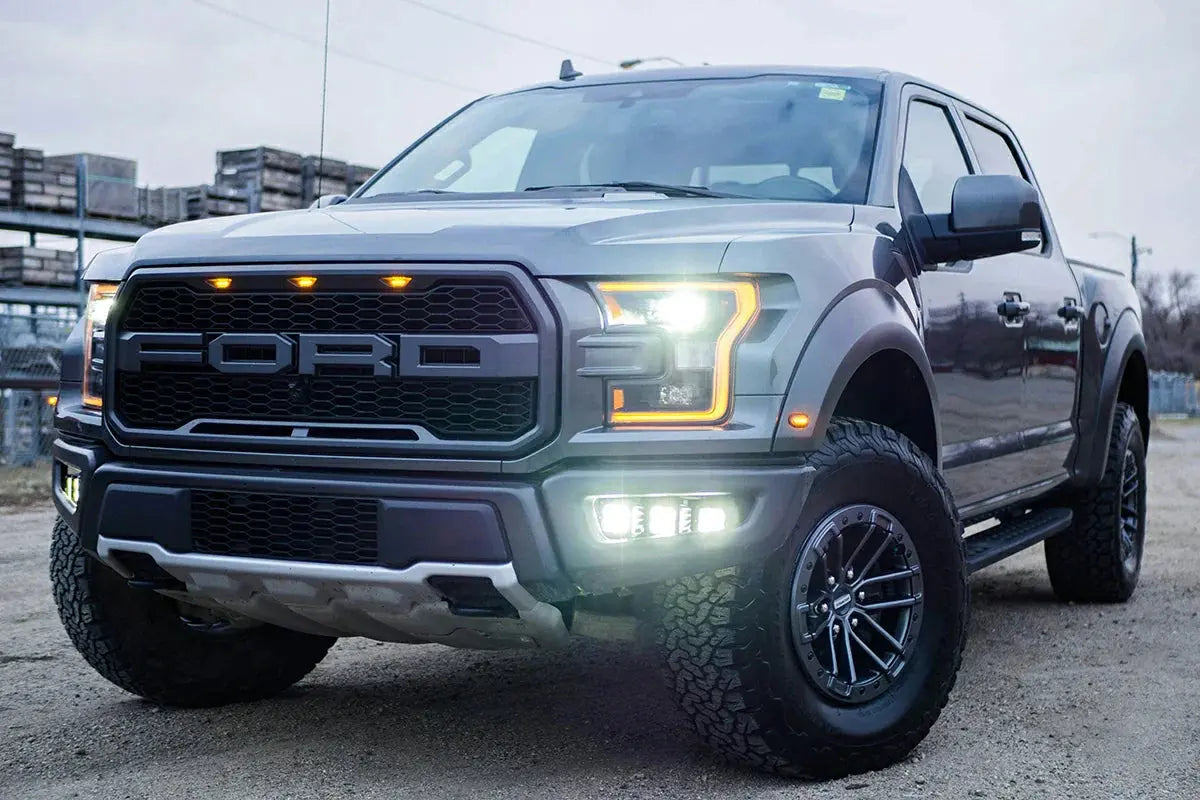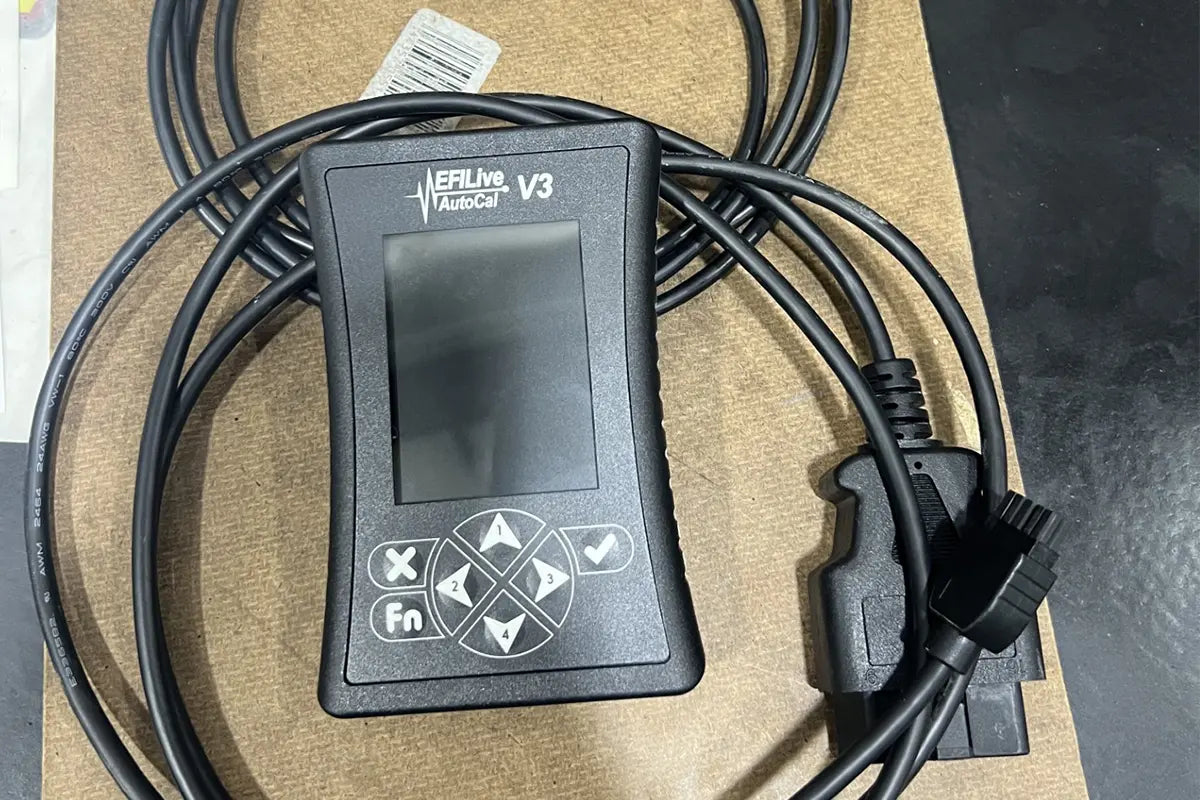Author: Lars, Diesel Truck Modification Enthusiast at SPETUNER
Understanding whether a diesel truck has been deleted is crucial information for buyers, sellers, and current owners. This comprehensive guide will walk you through all the methods to identify a deleted diesel truck, what deletion means, and the implications of owning one.
What Does "Deleted" Mean for Diesel Trucks?

A deleted diesel truck has had specific emissions control systems removed or disabled. The most common deletions involve three primary systems:
DPF Delete - Removes or bypasses the filter that captures soot and particulate matter from exhaust gases. The DPF (Diesel Particulate Filter)normally goes through regeneration cycles to burn off accumulated soot.
EGR Delete - Disables or removes the system that recirculates a portion of exhaust gas back into the engine cylinders to reduce nitrogen oxide emissions and lower combustion temperatures.
DEF/SCR (Diesel Exhaust Fluid/Selective Catalytic Reduction) Delete - Bypasses the system that injects urea-based fluid into the exhaust stream to convert harmful nitrogen oxides into harmless nitrogen and water vapor.
These modifications require both physical component removal and engine tuning to prevent check engine lights and maintain proper operation.
How to Tell if a 6.7 Powerstroke Has Been Deleted
The 6.7 Powerstroke diesel engine, found in 2011+ Ford Super Duty trucks, has specific indicators when deleted:
Visual Signs on 6.7 Powerstroke
- Missing DPF canister under truck - Stock 6.7 Powerstrokes have a large DPF between the downpipe and muffler. A deleted truck will have a straight pipe.
- EGR cooler removal - Located on the passenger side of the engine, the EGR cooler is a large component. Look for block-off plates or missing cooler assembly.
- DEF tank absence - Check the driver's side frame rail for the blue-capped DEF tank. If missing, the truck has been deleted.
- Tuner in cab - Common tuners for 6.7 Powerstroke deletes include SCT, H&S Mini Maxx, or Edge products plugged into the OBD-II port.
Performance Indicators
- No DPF regeneration cycles (stock 6.7s regen every 300-500 miles)
- Louder exhaust note with deeper tone
- Black soot visible in exhaust tips
- DEF gauge reading stuck at maximum range
How to Tell if a Duramax Has Been Deleted
Duramax engines (6.6L in GM/Chevy trucks) have their own telltale deletion signs:

Duramax-Specific Indicators
- Exhaust system inspection - Crawl under the truck and look between the transmission and rear axle. Stock Duramax trucks have a large DPF canister. Deleted trucks feature straight pipes or aftermarket exhaust.
- EGR valve location - On Duramax engines, the EGR valve is on the driver's side. Check for missing components or block-off plates.
- Cruise control function - Some Duramax delete tunes (like older GDE tunes) enable cruise control below 25 mph, which isn't available on stock trucks.
- Exhaust brake behavior - Deleted Duramax trucks may have modified exhaust brake functionality.
Dashboard Signs
- DEF level gauge never drops or shows unrealistic range (5,000+ miles)
- No DPF regeneration messages
- Absence of DEF quality warnings
How to Tell if DPF is Deleted
Identifying a DPF delete specifically involves these key checks:
Physical DPF Inspection Methods
Look under the truck: The DPF is typically the largest component in the exhaust system, located mid-chassis. A stock DPF looks like a large metal canister (often 12-18 inches long and 10-12 inches in diameter). A deleted truck will have:
- Straight pipe in place of the DPF canister
- Aftermarket exhaust pipe with smooth, unrestricted flow
- No heat shields or brackets associated with DPF mounting
Tailpipe Test
Soot accumulation check: This is the quickest method law enforcement uses:
- Deleted truck - Black soot visible inside the tailpipe, even with light use
- Stock truck - Exhaust tips remain clean; the DPF traps virtually all soot
Operational Signs
- No regeneration cycles - Stock trucks with DPF perform active regens every 300-800 miles (varies by use)
- No DPF pressure sensor readings - Scanning with OBD-II tool shows inactive or missing differential pressure sensors
- Improved fuel economy - Many owners report 2-4 mpg improvement after DPF deletion
How to Tell if EGR is Deleted
EGR deletion can be harder to spot but has distinct indicators:

Under-Hood EGR Checks
Visual inspection:
- EGR cooler removal - Look for block-off plates on the engine where the EGR cooler connects. On Cummins 6.7L engines, this is a large aluminum component on the passenger side.
- EGR valve inspection - Check if the EGR valve actuator is present. Some "stealth" deletes leave the actuator in place but remove the internal plunger.
- Disconnected hoses - EGR systems have multiple vacuum lines and coolant hoses. Capped or disconnected lines indicate deletion.
Functional Tests
- No EGR cooler flow - Feel the EGR cooler when engine is warm. A functioning system will have warm coolant flowing; a deleted system will be inactive.
- OBD-II scan - Check for EGR valve position and flow rate in live data. Readings stuck at 0% indicate deletion.
- Intake manifold inspection - Remove intake pipe and check for carbon buildup. Deleted EGR systems result in much cleaner intake manifolds.
Partial EGR Deletes
Some trucks have "EGR-only" deletes while keeping DPF and DEF systems:
- DPF and DEF components still present under truck
- Only EGR cooler and valve removed or disabled
- Tuning required to prevent check engine lights
Visual Inspection Methods: Checking Under the Truck
The most straightforward way to identify a deleted diesel truck is through a visual inspection of the exhaust system underneath the vehicle.
Examining the Exhaust System
Look for the DPF canister: On stock trucks, you'll see a large cylindrical component in the exhaust system that houses the diesel particulate filter. This is typically located between the downpipe and the muffler. A deleted truck will have a straight pipe or aftermarket exhaust pipe in place of this bulky factory component.
Check exhaust routing: Factory exhaust systems with emissions equipment have multiple bends and connections to accommodate the DPF, DOC (Diesel Oxidation Catalyst), and SCR components. A deleted truck often features a much simpler, straighter exhaust path from the turbo to the tailpipe.
Inspect for the DEF tank: The DEF tank is usually mounted on the driver's side frame rail or near the fuel tank. If this blue-capped tank is missing or has been removed, the truck has undergone a DEF delete.
Under-Hood Inspection
EGR system check: Open the hood and look for the EGR cooler and valve assembly on the passenger side of the engine. On Cummins 6.7L engines, this is a large aluminum component. A deleted truck may have:
- Block-off plates where the EGR cooler was mounted
- Missing EGR valve and actuator
- Disconnected or capped vacuum lines and electrical connectors
Look for tuning devices: Check for programmers or tuners plugged into the OBD-II port under the dashboard, or loose in the glove box. Common tuners used for deletes include devices from manufacturers like H&S, Edge, Banks, and others. These are necessary to prevent check engine lights after physical deletion.
Interior and Dashboard Signs
DEF Gauge Readings
One of the most telling signs from inside the cab is an abnormal DEF gauge reading:
Frozen or maxed-out DEF range: If the dashboard shows 65,000+ miles until DEF refill is needed, or if the gauge never moves down after extended driving, this strongly suggests a DEF delete with tuning.
No DEF warnings: Stock trucks will display warnings when DEF levels get low. If you never see these warnings despite not refilling DEF, the system has likely been deleted.
Check Engine Light Behavior
While a properly deleted and tuned truck shouldn't have a check engine light, improper deletions or partial deletes may show:
- Persistent check engine lights related to emissions sensors
- Codes for DPF pressure, NOx sensors, or DEF quality
- CEL that clears on startup (some tuners can be programmed to auto-clear codes)
Exhaust and Performance Characteristics
Tailpipe Inspection
The condition of the tailpipe can reveal deletion status:
Soot accumulation: A properly functioning DPF keeps exhaust tips very clean. If you see black soot inside the tailpipe, the truck is likely deleted. This is one of the quickest checks law enforcement and inspectors use.
Clean tips on old trucks: Conversely, if a high-mileage diesel has pristine exhaust tips, it still has functioning emissions equipment.
Exhaust Sound and Smell
Louder exhaust note: Deleted trucks typically have a noticeably louder, more aggressive exhaust sound, especially at idle and under acceleration. The DPF acts as a muffler, so its removal creates more noise.
Diesel smell: Stock modern diesels with properly functioning emissions systems have minimal smell. Deleted trucks often have a stronger, more traditional diesel exhaust odor.
Visible smoke: While not all deleted trucks "roll coal," any visible black smoke under normal acceleration is a strong indicator of deletion. Stock emissions systems prevent visible smoke except under extreme load.
Driving Characteristics
No regeneration cycles: Factory trucks with DPF systems periodically perform active regenerations, which drivers notice as:
- Slightly reduced fuel economy during the cycle
- Increased exhaust temperature and smell
- Higher idle RPM
- Dashboard messages about regeneration in progress
If you never experience these symptoms, the truck may be deleted.
Improved throttle response: Many deleted trucks show noticeably sharper throttle response and increased power delivery, especially in the low to mid-range RPM band.
Diagnostic Methods
OBD-II Scanning
Using a quality diagnostic scanner can reveal deletion:
Missing or inactive sensors: Scan for DTCs (Diagnostic Trouble Codes) and monitor live data. Look for:
- NOx sensor readings stuck at fixed values (typically 1832°F for EGT sensors)
- Missing DPF pressure differential readings
- Inactive DEF quality or level sensors
Custom tuning signatures: Some scan tools can identify non-stock ECM calibrations, though sophisticated tuning makes this harder to detect.
Computer System Analysis
ECM programming inspection: A thorough diagnostic check at a dealership can sometimes reveal if the ECM has been reflashed with delete tuning, though this requires forensic-level analysis and isn't part of standard inspections.
Tampering indicators: Some newer trucks store flags when the ECM is reflashed with non-OEM software, which dealers can detect.
Common Combinations and Partial Deletes
Not all deletions are complete. Understanding partial deletes helps with accurate identification:
EGR-Only Delete
Some trucks have only the EGR system disabled to reduce oil contamination and extend engine life while keeping DPF and DEF systems functional. Signs include:
- EGR cooler and valve removed or blocked off
- DPF and DEF systems still present
- Minimal external evidence without under-hood inspection
"Stealth" or "California-Style" Deletes
To pass visual inspections, some owners:
- Gut the DPF but leave the canister in place
- Disable EGR but leave components installed
- Keep all external appearance stock while systems are non-functional
These are harder to detect visually but will show symptoms like soot buildup with seemingly stock components.
Is It Illegal to Delete a Diesel Truck?
Yes, deleting a diesel truck is illegal under federal law in the United States, regardless of the state you live in.
Federal Law on Diesel Deletes
Clean Air Act violations: Removing or disabling emissions control equipment violates Section 203 of the Clean Air Act. This applies to:
- Any vehicle used on public roads
- Both the person performing the deletion and the vehicle owner
- Partial deletes (EGR-only, DPF-only) and complete deletions
Penalties and Fines
Individual vehicle owners: Can face fines up to $5,000 per violation. With multiple components deleted (EGR, DPF, DEF, SCR), fines can exceed $20,000.
Shops and installers: Face much steeper penalties - up to $4,807 per non-compliant vehicle, plus up to $50,120 per day of violation. The EPA has shut down multiple delete kit manufacturers and tuning companies.
State-Level Enforcement
While federal law prohibits deletions everywhere, state enforcement varies:
- Strict enforcement states: California, Colorado, and northeastern states conduct emissions testing that will catch deleted trucks
- Limited enforcement states: Texas, most Midwest and Southern states only require safety inspections with no emissions testing
- Visual inspections: Some states perform visual checks for emissions equipment even without emissions testing
Is It Illegal to Buy a Deleted Truck?
The legality of purchasing a deleted truck is complex and depends on several factors:
For Individual Buyers
Private sales: It's not illegal to purchase a deleted truck from a private seller. However:
- You may have difficulty registering the vehicle in emissions-testing states
- You cannot legally drive it on public roads
- You assume responsibility for the illegal modifications
- Warranty is voided on the entire powertrain
Dealer Sales Prohibition
Licensed dealers cannot sell deleted trucks: Federal law explicitly prohibits dealers from selling vehicles with emissions equipment removed or disabled. Dealers who do face:
- Significant EPA fines
- Potential loss of dealer license
- Civil liability to buyers
Some dealers may unknowingly sell deleted trucks that have had components reinstalled to appear stock.
Legal Use Cases
Deleted trucks can be legally owned and operated only in specific circumstances:
- Off-road use only: Racing, farm equipment, off-road recreation
- Export vehicles: Trucks being shipped to countries without US emissions requirements
- Show vehicles: Trucks never driven on public roads
How Much Does It Cost to Reverse a Deleted Truck?
Returning a deleted diesel truck to stock configuration is expensive and labor-intensive.
Parts Costs Breakdown
| System/Component | Cost Range | Details |
|---|---|---|
| DPF and SCR System | $2,000-$4,000 | Total System Cost |
| $800-$1,500 | Diesel Particulate Filter canister | |
| $600-$1,200 | SCR catalyst | |
| $400-$800 | DOC (Diesel Oxidation Catalyst) | |
| $200-$500 each | Sensors (NOx, DPF pressure, temperature) | |
| EGR System Components | $800-$1,500 | Total System Cost |
| $400-$800 | EGR cooler | |
| $300-$600 | EGR valve and actuator | |
| $100-$200 | Gaskets and hardware | |
| DEF System | $500-$1,000 | Total System Cost (if removed) |
| $200-$400 | DEF tank | |
| $200-$400 | DEF injector and lines | |
| $100-$200 | DEF quality sensors | |
| ECM Programming | $200-$500 | Total Programming Cost |
| $200-$400 | Factory programming restore at dealership | |
| $0-$100 | Software licensing fees |
Labor Costs
| Labor Type | Time Required | Rate | Total Cost |
|---|---|---|---|
| Standard Installation | 8-12 hours | $100-$150/hour | $800-$1,800 |
| Note: Complex installations on trucks with extensive modifications may require additional time. | |||
Total Cost to Return to Stock
| Restoration Level | Cost Range | Description |
|---|---|---|
| Minimum | $4,000-$5,000 | Basic DPF/EGR restoration with labor |
| Average | $6,000-$8,000 | Complete system restoration |
| Maximum | $10,000+ | Trucks with damaged components or extensive modifications |
Additional Considerations
| Factor | Impact |
|---|---|
| Component Availability | Older trucks may have discontinued parts that cost more |
| Used Parts Option | Can save 30-50% but may not last as long |
| Verification Testing | Emissions testing after restoration adds $50-$150 |
| Risk of Damage | Extended operation without emissions equipment may have damaged sensors or caused carbon buildup requiring additional repairs |
Professional Assessment Options
If you're unsure about a truck's status, consider:
Pre-purchase inspection: Have a diesel specialist inspect the truck before buying. This typically costs $150-$300 but can save thousands in unexpected costs.
Dealership diagnostics: Dealer service departments can perform comprehensive computer diagnostics to check for tampering, though this may cost $100-$200.
Trusted diesel shops: Independent diesel performance shops experienced with modifications can quickly identify deletion status and the quality of the work performed.
Questions to Ask When Buying
When considering a used diesel truck, ask the seller:
- Has the truck been deleted or had any emissions modifications?
- Do you have the original emissions components?
- Is the original tuner/programmer included with the truck?
- What tuning company performed the deletion?
- Can you provide documentation of the work performed?
- Has the truck passed state inspection, and in what location?
If a seller is evasive about these questions, consider it a red flag.
Red Flags and Warning Signs
Be cautious if you notice:
- Seller reluctance to discuss modifications
- Missing tuning device or programmer
- Recent attempt to "return to stock" with mismatched or poorly installed components
- Excessive exhaust smoke or soot
- Check engine lights that the seller dismisses
- Price significantly below market value for similar trucks
Using Quality Delete Products (For Off-Road/Racing Use)

For those legally using diesel trucks in off-road, agricultural, or racing applications where emissions regulations don't apply, quality delete components matter significantly.
We provide properly engineered solutions including:
- Precision-fit EGR delete kits, DPF delete kits, and even all-in-one full delete kits for various truck models
- High-flow exhaust systems designed to replace restrictive factory components
- Tuning solutions that properly calibrate the engine for deleted configurations
Quality-delete products ensure reliable operation and prevent engine damage that can result from improper deletions.
The Bottom Line
Identifying a deleted diesel truck requires attention to multiple indicators:
Most reliable indicators:
- Visual inspection of exhaust system for missing DPF
- Soot in tailpipe or on exhaust tips
- Missing or disconnected DEF tank
- Frozen or unrealistic DEF gauge readings
- Loud, aggressive exhaust note
- Visible black smoke under acceleration
Secondary indicators:
- Block-off plates or missing components under hood
- Tuner device present in vehicle
- Unusual OBD-II sensor readings
- No regeneration cycles
- Strong diesel exhaust smell
Understanding these signs helps you make informed decisions whether you're buying, selling, or evaluating your current truck. Always consider the legal implications and requirements in your specific location before purchasing or modifying a diesel truck.
Conclusion
Knowing how to identify a deleted diesel truck is valuable knowledge for anyone in the diesel truck market. Whether you're checking a 6.7 Powerstroke, Duramax, or any other diesel engine, the telltale signs—from sooty tailpipes and missing DPF canisters to abnormal DEF readings and loud exhaust notes—are usually straightforward to spot once you know what to look for.
Whether you're concerned about legal compliance, warranty coverage, or simply want to understand what you're buying, taking the time to thoroughly inspect a truck's emissions systems can save significant money and hassle down the road. With the cost to reverse a deleted truck ranging from $5,000-$10,000, it's crucial to identify deletion status before purchase.
Frequently Asked Questions
Can dealers sell deleted trucks?
No, it's federally illegal for dealers to sell vehicles with emissions equipment removed or disabled. However, some dealers may unknowingly sell deleted trucks that have had components reinstalled to appear stock.
Will a deleted truck pass inspection?
This depends entirely on your state and county requirements. States with only safety inspections and no emissions testing will generally pass deleted trucks. States with emissions testing will fail deleted trucks unless they're returned to stock.
How much does it cost to delete a diesel truck?
Complete delete kits with tuning typically cost $2,500–$5,000 for parts, plus installation labor if not done yourself. Quality components and professional tuning are essential for reliable operation.
How much does it cost to reverse a deleted truck?
Returning a deleted truck to factory configuration costs $5,000–$10,000, including parts ($3,000–$6,000 for DPF, EGR, DEF components) and labor ($800–$1,800 for 8–12 hours of installation work), plus dealer ECM programming ($200–$500).
Can you tell if a truck was deleted and then returned to stock?
Sometimes. Look for fresh tool marks on exhaust components, mismatched parts, recently installed sensors with clean connectors, or flags in the ECM showing previous reflashing. A DPF that was deleted and reinstalled may clog quickly if the tuning wasn't properly reverted.
Are partial deletes legal?
No. Any modification that removes or disables required emissions equipment violates federal law under the Clean Air Act, whether it's a complete or partial deletion.
Is it illegal to buy a deleted truck?
Purchasing a deleted truck from a private seller is not illegal, but driving it on public roads is. Dealers cannot legally sell deleted trucks. Deleted trucks can only be legally owned for off-road, racing, or agricultural use.
How do I know if my 6.7 Powerstroke is deleted?
Check for a missing DPF under the truck (between downpipe and muffler), a missing EGR cooler on the passenger side of the engine, an absent DEF tank on the driver's side frame rail, black soot in the exhaust tips, and DEF gauge readings that never change or show unusually high remaining range.
How can I tell if my Duramax is deleted?
Look under the truck between the transmission and rear axle for the DPF (normally a large canister). Check if cruise control operates below 25 mph (some delete tunes enable this). Inspect for black soot in the exhaust tips and see whether the DEF gauge never moves.

